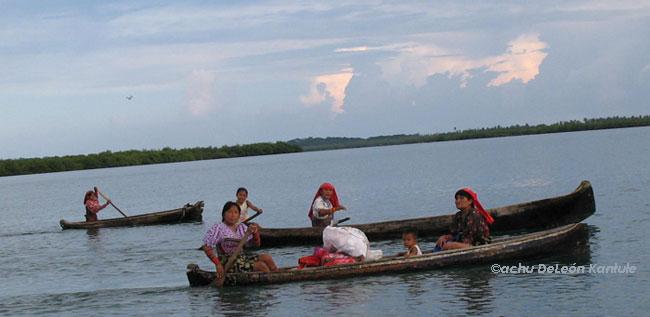Oswaldo DeLeón Kantule - "Achu" |
Kuna Yala

Location
The Autonomous Territory of Kuna Yala is found in the western part of the Caribbean coast of Panama. It is bordered on the west by the District of Santa Isabel in the province of Colon and on the southeast by the Republic of Colombia. To the north it touches the Caribbean Sea and in the south it ends in the heights of the "San Blas Range" which runs parallel to the coast. The width of the territory varies from 7 kilometers to 26 kilometers in the western part. The surface of the land is about 3,220 square feet.
The Autonomous Territory of Kuna Yala was recognized by Panama´s Law 16 of 1953. It includes a continental portion plus hundreds of islands, reefs and keys on the coast. Along the coast there are 365 islands, 49 of which are inhabited, and a great number of reefs and banks up to 18 kilometers from the coast.

History
According to the Saila (leader) Olonabiginya (Horacio Mendez, from the island of Ustupu, deceased), the Kuna people come from the north of what is known today as Colombia, perhaps from the Sierra Nevada in Santa Marta. From here they migrated to the Darien Jungle, to an area known as Amukadiwar (Atrato River). Today small groups of Kunas still live in the Darien Jungle. In the jungles of Darien the Kunas faced various indigenous groups and invaders such as the English, the Scottish, the French, and pirates, and they fought with some of them and allied themselves with others against the Spanish. It is possible that the migration to the north and to the islands took place in the mid-18th century, with some groups remaining on the coast, where they are still found today, such as in Navagandi and Mansucun. In 1871 the government of Great Colombia ceded the "Autonomous Territory of Tulenega" to the Kuna in order to "civilize the savages".
After the separation of Panama from Colombia in 1903, missionaries began to arrive with a mission to "civilize" and "christianize" the indigenous peoples. With the arrival of the Panamanian police and the invasion of unemployed people due to the end of the construction of the Panama Canal, the customs in the territory were threatened, such as ceremonial rituals such as puberty rites, healing and using indigenous costumes such as the mola. In addition to this, official schools and police stations were established, bringing with them discontent among the indigenous population, who were forced to change their customs and victims of mistreatment, arbitrary punishments and torture by the waga (non-Indigenous) police.
As a result of all of this, the Kuna community, led by Nele Kantule (from the island of Ustupu), Colman (from the island of Ailigandí), Olonibiginya (from Cartí) and others, the rebelled in the Tule Revolution of 1925.
The struggles to maintain the culture, the territory and the traditional ways of life continued, but in a different way. In 1930, the Panamanian State recognized the San Blas Reserve for the Kunas and in the Law of 1938 they guaranteed the Territory of San Blas. With the Law 16 of 1953, the Panamanian government defined the internal autonomy based on a document negotiated with the Kunas since 1945; with Law 20 in 1957 the Territory was designated an Indigenous Reserve, known today as Kuna Yala or Territory of the Kunas.
The document of 1953 represents the internal constitution of the Kuna Government in their territory. It regulates the hierarchy of the administration, which consists of: a) The General Congress of the Kuna Culture, b) the Kuna General Congress, c) the Sailagan Dummagan or the Chiefs, d) the Local Congresses and e) the Sailagan or Local Leaders.
The Local Congresses meet daily and are the highest religious, cultural, and political authorities in the communities. The local Leaders are the legitimate authority in their respective communities. In the daily Congresses (Onmaket) they invoke and pay homage to Pab Dummat (the Kuna religious figure) and they attend to all aspects of community life.

Spiritual Concepts of the Kuna
The Kuna people recognize their official religion to be that of Ibeorgun, who was the main Kuna prophet, who came to teach the way of life that should be followed, according to Paba and Nana (also the words for Father and Mother) as inseparable higher beings, not as parents, but rather using a different logic that is original and distinct to the Kuna.
The Kuna world vision consists of spiritual and substance elements; both are inseparable just as the spiritual and the material are inseparable. Both are present in all rivers, oceans, mountains, hills, forests, and rocks. It is for this reason that the so-called "Galus" are strictly respected as the specific homes of spirits, which may be found anyplace. There is a Galu for every being: for snakes, for crocodiles, jaguars, birds, etc. This world vision is part of the essential orientation in Nabguana or Mother Earth.
According to the Kuna world vision, the world is divided into eight levels, with human beings living on the surface of the earth, known as Neg Kunas (this is where the name Kuna comes from), and this is the level that divides the others in half: that is to say that for the Kunas there are four levels below the earth and four levels above, and in the middle live human beings. Each level is inhabited by spirits, either good or evil, and only the Neles can visit these places in their (mental) travels.
©2008 Oswaldo DeLeón Kantule web design AlSan